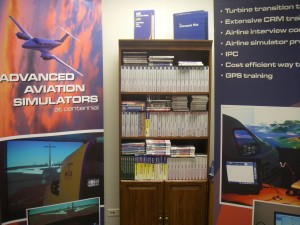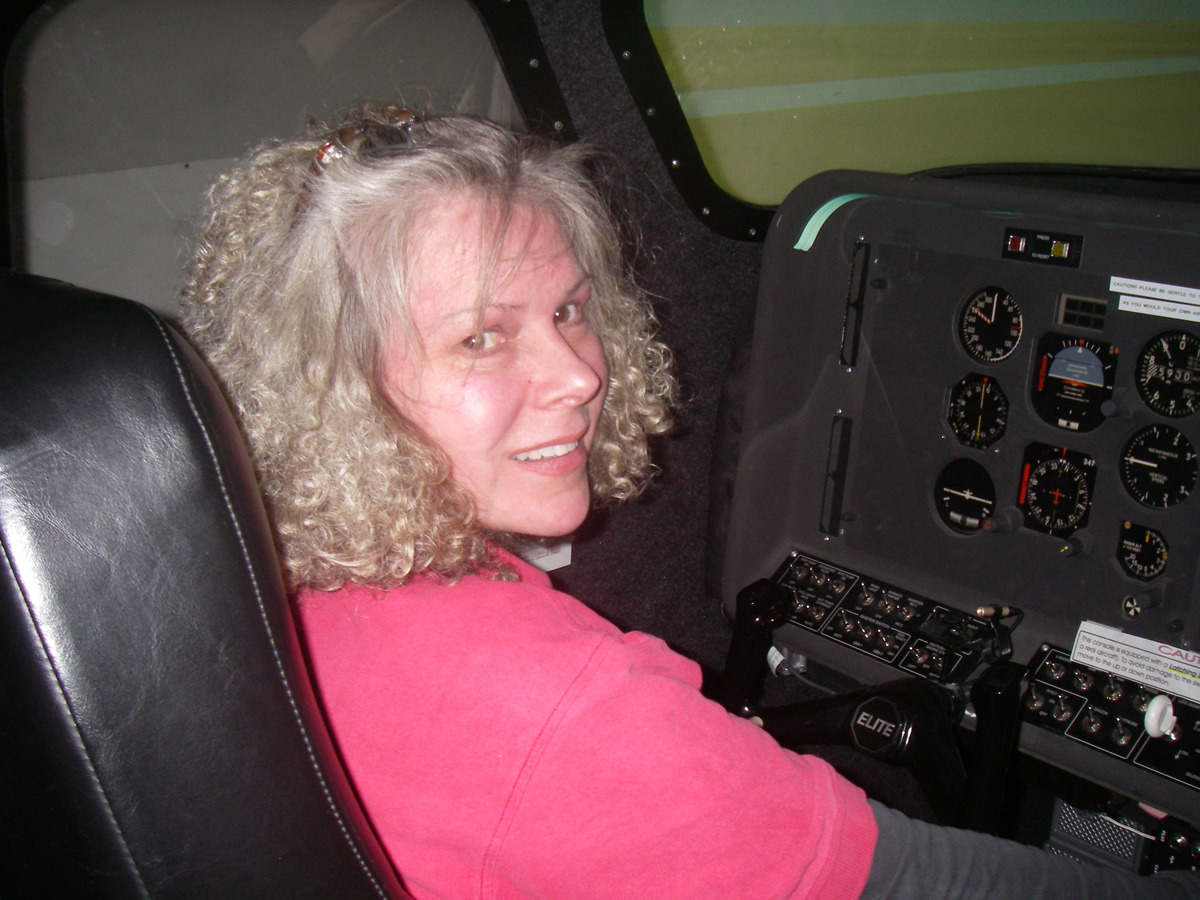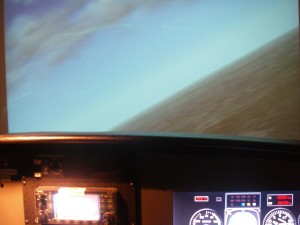By Geoff Flossic

Lisa Neifert, owner of Advanced Aviation Simulators, is in the left seat of the ELITE King Air 200 simulator.
You’re arriving on the TOMSN FOUR ARRIVAL, descending down to FL 19000. ATC tells you to do best forward speed, 250 knots, prior to reaching TOMSN intersection. You run through the descent checklist again to confirm that the TCAS is set, the pressurization is set and all the anti-ice is on, knowing that you have some bad weather ahead. With a 30-knot tail wind, you leave the bright blue, sunny skies, descending down into the dark soup with a light to moderate chop. Looking up, you notice the windshield and antennas are accumulating rime ice fast. You make a PIREP report to Denver Center that you’re collecting rime ice at 22,000 feet and the temperature is -15.
After TOMSN intersection Denver Center, busy with other traffic, gives you vectors to Denver runway 35R approach, you go through the approach and landing checklist while monitoring the rime ice, which is getting worse. Flying in the chop and packing on the ice, the number two engine fails, with master warning light on and flashing in your face. Pressure builds and your heart pounds as you begin to perspire. Stunned and trying to collect your composure, you go through the memory items, thinking, “What did I forget?”
The workload is notched up to the tenth power! You pick up the “wine list” and open to the emergency engine-out procedures. You contact ATC that you lost the number two engine and are declaring an emergency, requesting priority landing because of the ice. ATC tells you to turn left to 030 and descend down to 9,000, and asks, “How many souls on board?” You reply that there are eight souls on board, including yourself and your first officer.
ATC clears you to land on runway 35R. Winds are out of 300 at 20 knots, gusting to 30. ATC tells the Citation behind you to slow down. The Citation replies that they can’t go any slower because they’re packing on a lot of rime ice.
“This has got to be my worst nightmare,” you think to yourself. You call out, “Localizer alive,” and moments later, “Glide slope captured,” “Dot and a half, “Gear down, in transit, three in the green,” watching and maintaining localizer, glide slope and airspeed.
You think to yourself, “I can’t screw up this approach.” Your head is pounding. You call out, “One thousand feet to minimums,” “Five hundred feet,” and then “Two hundred feet.”
You look up, saying, “Lights in sight, continuing, 50 feet, 80 knots, landing.” The tower tells you to taxi off any taxiway and stay on that frequency. The instructor at the station puts the sim in flight pause, and say’s “Not too bad, but you need to do better. Tomorrow, we’ll work on the LOFT (line orientation flight training), Houston/Hobby, Dallas/Ft. Worth.”
After this workload, you need an Advil.
These are just a few things Advanced Aviation Simulators Inc. does in training.
“We train all levels of flight training, from private pilot to airline,” say’s Lisa Neifert, owner of Advanced Aviation Simulators, located at Centennial Airport. “We have a lot of clients that fly in from all over the country to get our airline interview consulting and simulator prep.”
Neifert said they help about a hundred pilots annually, and have been very successful getting them hired on to the airlines.
“A lot of the pilots that did our airline prep and supplemental training are now upgraded captains today,” She said. “The thing we see in simulator training is that a lot of the pilots have a weak scan or no scan at all.” If you haven’t flown, or flown instruments for a while, do not apply for the airlines!”
She said the resume only gets you the interview; it doesn’t get you hired.
“It’s not about getting hired either,” she said. “It’s about keeping your career during and after IOE (initial operating experience).”
Neifert said a very high percentage of washouts happen during IOE.
“Job is an acronym; it stands for ‘just over broke’!” she said. “What you want is a career! I tell people, ‘You’re as good as your last check ride. Teaching instrument students doesn’t make you a good instrument pilot, because you’re not at the helm in actual IFR.'”
Neifert said that scan and skill deteriorates 80 percent when you’re not applying them on a regular basis.
“If you don’t use it, you lose it, and you need to be rock solid on the instruments and airspeed control to be a strong candidate for an airline career,” she said. “The airlines are looking to hire captains, not first officers.”
Neifert owns five simulators; a sixth one is on its way. Pilots train in the Modular Flight Deck, which can simulate 14 different aircraft, from single to multi-engine aircraft. The flight controls have hydraulic dampening, which makes it feel like the actual aircraft being used. If the simulator is set up as a Cessna 421, the controls will feel like a 421. The simulators have both internal and external visuals, and are equipped with Garmin GNS 430 GPS systems. The multiple computers drive the visuals, hardware and software, using the FAA approved commercial X Plane. The simulators are so state of the art, they simulate thunder and lightning, rain and hail—and the sound effects are real! If you’re in a simulated rainstorm, you can hear rain hitting the fuselage. The software simulates fronts, barometric changes, icing microbursts, wind shear, engine fire, hydraulic, vacuum, electrical, broken flap, gear failures, etc.
The Aircraft Owners and Pilots Association and the Washington FAA are looking at the Advanced Aviation Training Device very closely, because of the training value and the learning retention.
“Pilots get better training from these kinds of simulators,” Neifert said. “The instructor can focus on areas on which their students need to work. He/she can flight freeze the sim any time during the training and thoroughly and safely discuss their weak areas.”
She said the AATDs are “time machines.”
“They save you time and money,” she said. “They’re easy on the wallet. You can accomplish six to eight approaches and make them all different in a two-hour time session, focusing on the busiest parts of the flying, departures, holdings and arrivals.”
She said students flying the AATDs first transition better to the airplane, without getting discouraged, overwhelmed or frustrated.
“They’re more confident and better organized in the cockpit,” she said. “They also stay on to complete their pilot’s license and move on to further ratings.”
She said that makes better, safer pilots at a very affordable training cost.
“This is a win-win situation,” she said. “They stay active at their flying club. Why should only the rich have access to the high-dollar, state-of-the-art flight simulators with the expensive instructors? It doesn’t have to be that way! That’s why I have a simulator club, the Colorado IFR Club.”
Chris Worley spent about $ 2,000 to finish his instrument rating. The price included instructor time, plane rental for his IFR cross–country and cost of the examiner.
“I had 24 hours under-the-hood time, and I spent 18 hours training in Lisa’s simulator, with Jay Silvernale, my instructor,” Worley said. “I finished my instrument rating in eight days.”
Fifty hours can be logged toward the commercial, 25 towards the ATP, 20 towards the instrument, and 2.5 hours towards the private pilot’s certificate. Instructors can also log the AATD as part of the ground school. Neifert has a King Air B200 crew trainer, made by Elite.
“We do a lot of 1900D profiles and callouts, CRM, LOFT training.” Neifert said. “This sim can simulate hot starts and hung starts, along with other system emergencies. We do a lot of training on the hot starts and temperature of the day. This is important; you can burn up an engine fast if you don’t know what you’re doing, and that will cost you your job.”
Jesse Gamueda is Neifert’s chief pilot and King Air instructor. He trains the Colorado State Patrol and Mountain Aviation, Inc. Todd Sickles, a captain for Sky West Airlines, does the LOFT and sim prep. The other instructors are Mike Bullock, CFI; George Kirwin and Lee Croissant, retired United captains; and Richard Shirley, captain and line check man for Evergreen International Aviation.
Advanced Aviation Simulators has about 200 club members; several companies use Neifert’s services. She also supplies a classroom full of DVDs, CDs, tapes and books. She even has the complete Cal. Tech Physics, a 52-video series.
“You name it; I have it,” she said. “I want a complete training and learning environment—just like The United Training Center—all here, at Centennial Airport.”

Advanced Aviation Simulators offers a large library of videos, DVDs and CDs for use in the classroom.
According to the FAA website, the number of issued private pilot certificates has declined since 2002. That concerns Neifert and is one of the reasons she has an “open-door policy.”
“Sometimes a pilot would like to join the club, but can’t quite afford it that particular month,” she said. “I let them in anyway; they can watch the DVDs and read my books. I want them to learn and have a complete knowledge on everything. Besides the videos, Neifert offers a cutout of actual size of a CRJ 200 and 1900D instrument panels, called “paper tigers,” for CPT training.
She also offers resume and cover letter service.
Neifert started Advanced Aviation Simulators in 2004 with just one room. Her business now fills almost half of the second floor of the Tac Air Hangar # 8 building. She’s always adding new products to her sim center. Pilots should come and see this place; it’s worth the time to visit.
Advanced Aviation Simulators is located at 7395 S. Peoria St., room #204, Tac Air Hangar # 8. Advanced Aviation is also located in Las Vegas and Tulsa Oklahoma. For more information, visit [http://www.prosimtraining.com] or call 303-649-9901.














